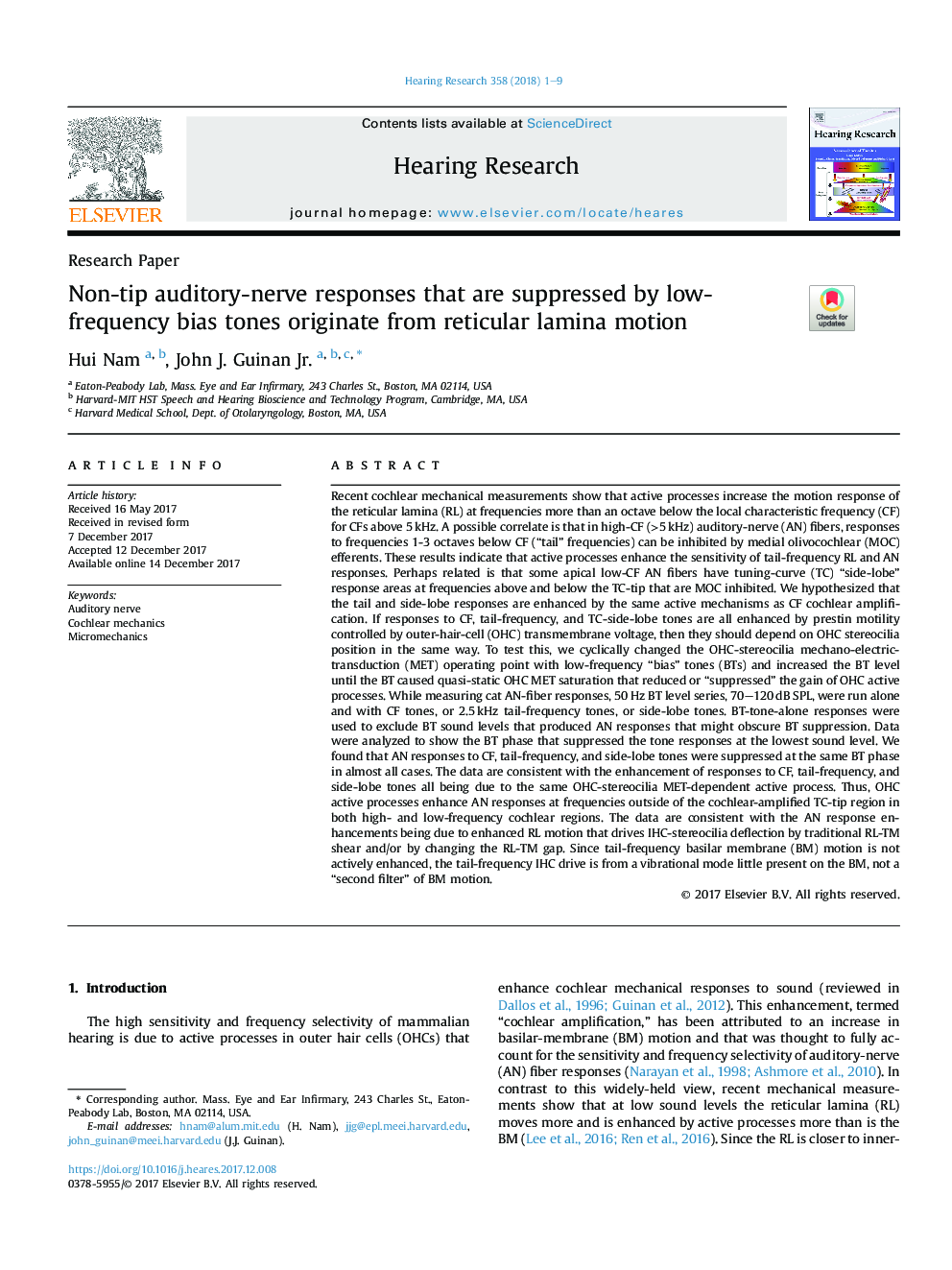| کد مقاله | کد نشریه | سال انتشار | مقاله انگلیسی | نسخه تمام متن |
|---|---|---|---|---|
| 8842423 | 1615542 | 2018 | 9 صفحه PDF | دانلود رایگان |
عنوان انگلیسی مقاله ISI
Non-tip auditory-nerve responses that are suppressed by low-frequency bias tones originate from reticular lamina motion
ترجمه فارسی عنوان
پاسخهای عصبی شنوایی بدون نوک که با تنهای تعویض کم فرکانسی سرکوب می شوند از حرکت لامینی مجدد
دانلود مقاله + سفارش ترجمه
دانلود مقاله ISI انگلیسی
رایگان برای ایرانیان
کلمات کلیدی
عصب شنوایی، مکانیک کچلر، میکرومکانیک،
موضوعات مرتبط
علوم زیستی و بیوفناوری
علم عصب شناسی
سیستم های حسی
چکیده انگلیسی
Recent cochlear mechanical measurements show that active processes increase the motion response of the reticular lamina (RL) at frequencies more than an octave below the local characteristic frequency (CF) for CFs above 5â¯kHz. A possible correlate is that in high-CF (>5â¯kHz) auditory-nerve (AN) fibers, responses to frequencies 1-3 octaves below CF (“tail” frequencies) can be inhibited by medial olivocochlear (MOC) efferents. These results indicate that active processes enhance the sensitivity of tail-frequency RL and AN responses. Perhaps related is that some apical low-CF AN fibers have tuning-curve (TC) “side-lobe” response areas at frequencies above and below the TC-tip that are MOC inhibited. We hypothesized that the tail and side-lobe responses are enhanced by the same active mechanisms as CF cochlear amplification. If responses to CF, tail-frequency, and TC-side-lobe tones are all enhanced by prestin motility controlled by outer-hair-cell (OHC) transmembrane voltage, then they should depend on OHC stereocilia position in the same way. To test this, we cyclically changed the OHC-stereocilia mechano-electric-transduction (MET) operating point with low-frequency “bias” tones (BTs) and increased the BT level until the BT caused quasi-static OHC MET saturation that reduced or “suppressed” the gain of OHC active processes. While measuring cat AN-fiber responses, 50â¯Hz BT level series, 70-120â¯dB SPL, were run alone and with CF tones, or 2.5â¯kHz tail-frequency tones, or side-lobe tones. BT-tone-alone responses were used to exclude BT sound levels that produced AN responses that might obscure BT suppression. Data were analyzed to show the BT phase that suppressed the tone responses at the lowest sound level. We found that AN responses to CF, tail-frequency, and side-lobe tones were suppressed at the same BT phase in almost all cases. The data are consistent with the enhancement of responses to CF, tail-frequency, and side-lobe tones all being due to the same OHC-stereocilia MET-dependent active process. Thus, OHC active processes enhance AN responses at frequencies outside of the cochlear-amplified TC-tip region in both high- and low-frequency cochlear regions. The data are consistent with the AN response enhancements being due to enhanced RL motion that drives IHC-stereocilia deflection by traditional RL-TM shear and/or by changing the RL-TM gap. Since tail-frequency basilar membrane (BM) motion is not actively enhanced, the tail-frequency IHC drive is from a vibrational mode little present on the BM, not a “second filter” of BM motion.
ناشر
Database: Elsevier - ScienceDirect (ساینس دایرکت)
Journal: Hearing Research - Volume 358, February 2018, Pages 1-9
Journal: Hearing Research - Volume 358, February 2018, Pages 1-9
نویسندگان
Hui Nam, John J. Jr.,
